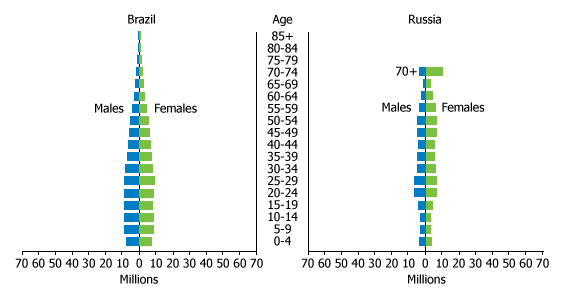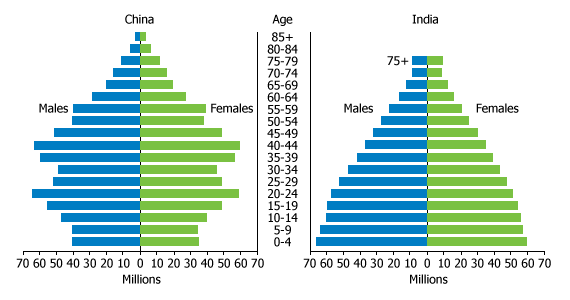Carl Haub
Former Demographer Emeritus

(April 2012) For some time now, Brazil, Russia, India, and China have been grouped together under the acronym BRIC. The BRICs are described as countries at the same stage of economic development, but not yet at the point where they would be considered more developed countries. The BRIC position argues that, since the four countries are “developing rapidly,” their combined economies could eclipse the collective economies of the current richest countries of the world by 2050.
The combined 2010 gross national income of the BRICs was US$10.5 billion, 25 percent of the GNI of high-income countries (see table). In 2009, it was 15 percent of the world total. The BRICs rank quite high in terms of global GNIs and China has almost certainly overtaken Japan by now to claim the second spot.
Brazil, Russia, India, and China, Selected Indicators
| Indicator | Brazil | Russia | India | China |
|---|---|---|---|---|
| Population mid-2011 (millions) | 197 | 143 | 1,241 | 1,346 |
| Population 2050 (millions) | 223 | 126 | 1,692 | 1,313 |
| Percent of population <age 15 | 25 | 15 | 33 | 17 |
| Total fertility rate | 1.9 | 1.6 | 2.6 | 1.5 |
| Percent of population living <$US2/day | 10 | 1 | 76 | 36 |
| 2010 gross national income (in billions)* | $1,830 | $1,404 | $1,554 | $5,721 |
| 2010 world rank for GNI | 8 | 12 | 11 | 3 |
| 2010 gross national income per capita* | $9,390 | $9,910 | $1,340 | $4,260 |
| GNI growth rate (%), 2009-2010 | 15.8 | 6.3 | 10.1 | 17.1 |
* Atlas method.
Sources: Population Reference Bureau; United Nations Population Division; International Labour Organisation; National Statistical Offices; and World Bank.
The picture changes dramatically when we consider the countries’ rank on GNI per capita. The size of their economies is largely a result of population size.The BRICs are among the top 10 countries in the world in population.
Will the BRIC economies really eclipse the world’s wealthier countries? Table 1 offers one way to quantify that possibility. The high GNI growth rates of China and India are partly due to the still relatively small size of their economies. As economies grow, we can expect rates of growth to decrease simply because the denominator, GNI, will grow. Let’s assume that the BRICs will average a 4 percent GNI growth rate for the next 40 years and the high-income countries will average 2 percent. That latter assumption, of course, posits that the current recession will end at some point. And, an assumption of 4 percent growth for the BRICs over such a long period is rather generous. Under that scenario, the combined income of the BRICs would rise from 25 percent of the high-income countries’GNI in 2009 to 49 percent in 2050. Not exactly an eclipse but significant growth nonetheless.
Age is all-important for its effect on the size of the labor force. India remains a rather young country with 33 percent of its population below age 15. Brazil is not far behind at 25 percent, while China and Russia, due to their very low birth rates, have only 17 and 15 percent, respectively.
The population pyramids (age and sex structure) of all four BRIC countries are quite different, primarily a result of their different birth histories. Brazil and China are somewhat similar, reflecting their transition to low birth rates. Brazil’s total fertility rate (the average number of children per woman) is now at a low, industrialized-country level of 1.9 children per woman. India has also made considerable progress in its fertility transition, but its TFR is still about 2.6.
Age and Sex Structure of Brazil (2010) and Russia (2010)

Sources: Brazil: United Nations; Russia: GOSKOMSTAT.
Age and Sex Structure of China (2010) and India (2011)

Sources: China: IDB; India: PRB/PFI projections.
China and Russia present two unusual age structures. China’s jagged pyramid results from a number of factors: mass deaths, social disruption, and the country’s “one-child” policy, all of which affected the population structure. In Russia, the economic disruption following the breakup of the USSR dropped the TFR below 1.2 in 1999, although it had risen to nearly 1.6 by 2010 (a rise that slowed in 2011). India is the “youngest” country of the group, and even by 2050, the 0-4 age group will be virtually equal to the 5-9 group.
Both China and India still have substantial proportions of their labor force engaged in agriculture, but in India the proportion is a whopping two-thirds. In India, only about 7 million people work in the “organized” manufacturing sector (factories that register with the government and, supposedly, maintain records and pay workers required benefits). These workers, however, account for about two-thirds of manufacturing output while earning a comparatively high wage equivalent to US91 cents per hour in 2006.1 The great majority of India’s labor force of 400 million work in the unorganized sector, where work varies from casual day labor to work in small shops and fabrication facilities and for which comparable labor force data are not available.
The large proportion of the population living in poverty—abject poverty—is often overlooked. The World Bank estimates that 76 percent of the population in India lives on less than US$2 per day, compared to 36 percent in China. Over 900 million people living in poverty in India, most with little effective education, are not likely to share in the prosperity enjoyed by a few and are not likely to form the basis for an exploding consumer market anytime soon. China’s future is difficult to foresee in that it now faces unaccustomed population aging should it not relax its stringent one-child policy. But China, unlike India, is one of the world’s largest exporters.
Of the four BRIC countries, Russia seems a true outlier. Despite an uptick in the birth rate, it still had 130,000 more deaths than births in 2011, primarily due to a decrease of 106,000 deaths in 2011 from the 2010 level. It had reported nearly 1 million more deaths than births in 2000. Childbearing among women ages 20 to 29 and the number of women moving into those ages will diminish sharply over the next 20 years, even with some offsetting effects of immigration.
Several things need to happen for the BRICs to reach their advertised potential. In India, a massive campaign to provide potential workers with education and training will be required. The government is trying to tackle this daunting task but provincial politics can be a major obstacle. As an official from the impoverished state of Bihar once commented to me regarding the demographic dividend in his state, “Having a huge amount of illiterate people is not an advantage!” Relaxed regulations in the early 1990s for foreign investments jump-started the Indian economy. Will China follow? China has a clearly disadvantageous demographic profile, and may need to alter it through immigration or by allowing the birth rate to rise? At the very least, Russia will likely have to rely on immigration to fill its labor force gaps. Finally, Brazil does have the appearance of a country whose economy has reached an advanced stage with a high per capita GNI. That said, the current world economic situation can too easily reshape the very different societies of the BRICs.
Carl Haub is a senior demographer at the Population Reference Bureau.
